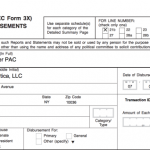If Trump Cuts This Little-Known Federal Program, It Will Gut Low-Income Communities
In light of the fact that Donald Trump recently announced he intends to increase the U.S.’s military spending by $54 billion, a federal program totaling just $258 million sounds fairly inconsequential. But the Community Development Financial Institutions (CDFI) Fund, which awards loans to institutions dedicated to promoting development and financial inclusion in disadvantaged areas, is a vital economic resource for low-income American communities. It costs each American just 79 cents per year.
In 2016, the $233.5 million in CDFI Fund appropriations translated into a total of $2.1 billion worth of investments and loans across the U.S.; as a result, the money resulted in the creation of 28,000 jobs. But in the Trump administration’s proposed new budget, submitted to Congress on March 16, the CDFI’s funds will be cut by $210 million, leaving it just $19 million to continue operation of its old programs, but not make any new grants.
The CDFI fund was launched by the U.S. Department of the Treasury in 1994 specifically to direct funds to disadvantaged communities. It does so by providing grants to CDFIs, which are private financial institutions that offer affordable lending to low-income communities that often cannot access lending resources offered through mainstream financial institutions due to a lack of solid credit history or an unwillingness to sign up for a bank account, which, because of late-payment and overdraft fees, are often seen as an impossible expense. There are over 1,000 CDFIs across the U.S., and though the grants that the CDFI Fund awards to CDFIs are relatively small, CDFIs are able to leverage those dollars to bring in private investors and create substantial funding streams that go directly into city and neighborhood-level projects.

While CDFIs operate in a wide range of areas across the U.S., the majority (67%) work in urban areas, and benefit low-income communities of color–ironically, the very communities that Trump claimed to want to help over the course of his campaign. Cutting the program that funds them, said CDFI Coalition President James R. Klein in a statement, would harm “precisely the communities President Trump seeks to help, including hollowed out inner-city neighborhoods and economically distressed rural communities.”
The CDFI Fund offers two types of loans to CDFIs: financial assistance awards and technical assistance awards. The latter are much smaller–up to $125,000–and the CDFIs applying for them don’t have to go through a certification process. For financial assistance awards, though, CDFIs have to apply for certification through the CDFI Fund; the certification process ensures that the CDFI is dedicated to supporting community development in a particular market. Those loans can total up to $2 million, and the CDFI availing of them must match its CDFI Fund award dollar-for-dollar with loans from private lending institutions; CDFIs partner with a variety of banks and nonprofits to round out the loans that they funnel into communities.
These loans have brought about a wide range of projects: A Los Angeles-based CDFI, Genesis LA, funded a transitional home for troubled youth; HOPE Enterprise Corporation, a Mississippi-based CDFI, connected people whose homes had been destroyed by Hurricane Katrina with mortgage-financing and home-recovery consulting services; Rural Community Assistance Corporation, a Sacramento CDFI, loaned a husband-and-wife tamale business $125,000 to refinance their loans and cover the cost of kitchen supplies.
Ellis Carr is the president and CEO of Capital Impact Partners, a Washington, DC-based CDFI with offices in Detroit and Oakland. He tells Co.Exist that when his company received a $2 million award from the CDFI Fund in 2014, it used that loan as a base to bring on board private and philanthropic partners, including JPMorgan Chase, and create a $30 million fund “that invested in Detroit at a time when everybody was taking a huge step back and no one was really providing long-term, fixed-rate financing in the midtown area,” Carr says. The unique financing structure that Capital Impact used in Detroit increased housing density in the midtown corridor and helped establish a new school and health facility.
“The dollars from the CDFI Fund allow us to do these innovative structures that bring in private investment and philanthropy,” Carr says. “But the Fund also allows us to be sustainable financially, because as a nonprofit lender, you need to consistently have equity to so that you can borrow more money from these institutions and continue to lend it to communities. The CDFI Fund gives us equity, which we leverage to bring in more private investment. If that federal CDFI Fund were to go away or be dramatically reduced, it would have a direct impact on the work that CDFIs are able to do across the country.”
The CDFI Fund also administers the New Markets Tax Credit (NMTC) program, which was established in 2000 to spur revitalization in low-income communities through offering private lenders a tax credit if they invest in Community Development Entities, which have a stated mission of supporting low-income communities and people. The NMTC, along with the program that administers it, is likely to face the chopping block under Trump’s budget and tax plans.
“With the current administration, some of the sound bites you hear are around the forgotten man or the forgotten people,” Carr says. “CDFIs have been doing this work for 30 years–we’ve been working with that forgotten population all along. So at a time when this country is really hurting, and can see the hurt in terms of people who are in need, we shouldn’t be talking about reducing the amount that goes to the CDFI Fund, that then goes to CDFIs and is invested in communities. We should be talking about how we should double it.”

But the problem is that CDFIs themselves tend to fly under the radar, says Lina Page, the executive vice president of strategic communications for the Opportunity Finance Network (OFN), a national association of CDFIs. “We know for a fact that CDFIs are among the best-kept secrets in America,” she says. “Not many people know what they are or what they do.” Because CDFIs are embedded in communities, responding to local needs and bringing in a variety of partners to deliver funds, they tend to blend seamlessly into the investment and development landscape. For people like Carr, that’s just part and parcel of CDFI’s mission: Companies like Capital Impact Partners don’t do the work they do for recognition or glory–they do it to get money to the people and communities that need it most.
But the lack of exposure, Page says, may be what’s driving the disregard with which the Trump administration is treating these organizations and the federal fund that supports them. “If people understood the impact of CDFIs, and how many amazing businesses, homes, jobs, health centers, and charter schools were funded by them, they would be celebrated,” she says.
To that end, OFN has begun to campaign for more recognition of CDFIs on a national scale, both through a social media advocacy campaign, called #CDFIsInvest in America, and through spreading the word about CDFIs in Washington in advance of Trump’s budget finalization. To do so, Liz Lopez, executive vice president for public policy at OFN, says they’re telling the story of CDFIs from the perspective of people who benefit from them. On a recent trip to the Hill, Lopez was speaking to a staffer, and asked if he’d heard of a local D.C. food truck called Arepa Zone. The staffer said yes; he’d eaten there plenty of times. Lopez asked if he knew they were able to purchase their truck only through the help of a CDFI loan; he said, no, what’s a CDFI? “I was able to explain to him that were it not for that first CDFI loan, they wouldn’t have been able to grow their business and create new jobs for eight people,” Lopez says.
When it comes down to it, Lopez says, the CDFI Fund is .0000068 percent of the total U.S. budget. To gut such a small yet effective program, that costs the average American half the price of a candy bar, is not only nonsensical; it will deprive those communities that Trump claims to want to help of yet another critical lifeline.
Fast Company , Read Full Story
(42)














